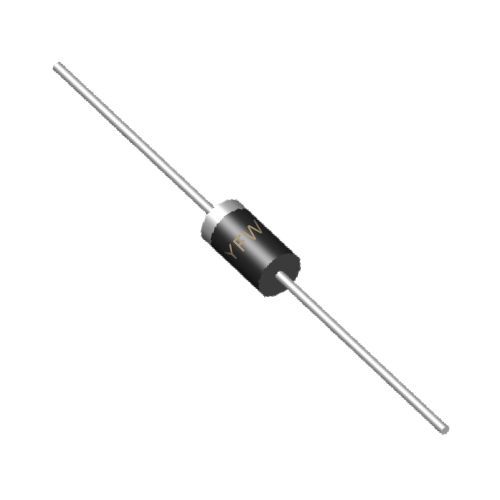One of the primary functions of Schottky diodes is rectification, where they convert alternating current (AC) to direct current (DC). Unlike silicon PN junction diodes, which exhibit a forward voltage drop of 0.6–0.7V, Schottky diodes operate with a significantly lower drop of 0.2–0.4V . This reduction in voltage loss translates to substantial energy savings, particularly in low-voltage, high-current applications such as 5V/10A power supplies. For instance, in computer motherboards or portable electronic devices, Schottky diodes minimize power dissipation during the rectification process, enhancing overall system efficiency and reducing heat generation .
Moreover, their low forward voltage drop makes them ideal for
synchronous rectification in
DC-DC converters. By replacing traditional diodes with Schottky devices, designers can achieve higher power density and efficiency, a critical factor in compact electronics like smartphones and laptops .
Schottky diodes excel in high-frequency environments due to their ultra-fast switching speeds. Unlike PN junction diodes, which suffer from minority carrier storage effects that delay their response time, Schottky diodes rely on majority carriers (electrons in N-type semiconductors), eliminating this delay. Their reverse recovery time (Trr) is typically less than 10 nanoseconds , making them suitable for applications such as radio frequency (RF) signal demodulation in AM radios or Bluetooth modules. In these scenarios, their ability to handle rapid signal transitions ensures accurate and efficient signal processing .
This high-frequency capability also benefits switching power supplies (SMPS), where Schottky diodes reduce switching losses and enable higher operating frequencies. By minimizing energy loss during transitions between and cutoff states, these diodes contribute to smaller, lighter, and more efficient power supply designs .
Schottky diodes play a vital role in
voltage clamping and protection circuits. For example, in USB interfaces, they act as
reverse polarity protection devices, preventing damage to sensitive electronics if the power source is incorrectly connected . Similarly, in low-dropout voltage regulators (
LDOs), Schottky diodes protect against reverse voltage spikes that could otherwise damage the regulator .
Their low forward voltage drop also makes them effective in voltage clamping applications, such as limiting signal amplitudes in analog circuits. By maintaining a stable voltage under varying input conditions, Schottky diodes ensure consistent performance in devices like audio amplifiers and sensor interfaces .
In circuits with inductive components (e.g., motors, relays, and transformers), sudden current interruptions can generate dangerous voltage spikes due to electromagnetic induction. Schottky diodes mitigate this risk by providing a for the inductive current, preventing damage to transistors and other components. For instance, in motor driver circuits, a Schottky diode placed across the motor terminals absorbs the back EMF (electromotive force) when the motor is turned off, ensuring safe and reliable operation .
This 续流 protection mechanism is equally crucial in switching power supplies, where it stabilizes the current flow through inductors and capacitors, reducing electromagnetic interference (EMI) and extending component lifespan .
Traditional silicon-based Schottky diodes face limitations in high-voltage and high-temperature environments due to their relatively low breakdown voltage (typically ≤200V) and temperature-sensitive leakage currents . However, advancements in semiconductor materials have led to the development of silicon carbide (SiC) Schottky diodes, which overcome these challenges.
SiC Schottky diodes offer a (3.26 eV for 4H-SiC) and high critical electric field strength (2.2 MV/cm), enabling them to handle higher voltages (up to 1.2 kV) and temperatures (up to 200°C) while maintaining low leakage currents . Their superior thermal conductivity (3.3× that of silicon) ensures efficient heat dissipation, making them ideal for high-power applications like electric vehicle (EV) chargers, solar inverters, and industrial motor drives .
For example, in EV onboard chargers, SiC Schottky diodes reduce energy loss during power conversion, enhancing charging efficiency and reducing heat management requirements. Similarly, in solar inverters, their fast switching speeds and low reverse recovery losses improve energy yield by 1–3% compared to silicon-based solutions .
The unique design of Schottky diodes provides several key advantages over PN junction diodes:
Lower Forward Voltage Drop: Reduces power loss and heat generation in low-voltage systems.
Faster Switching: Enables high-frequency operation and minimizes switching losses.
Protection: Safely handles inductive transients.
High-Temperature Stability: SiC variants excel in extreme environments.
However, Schottky diodes also have limitations, such as lower reverse breakdown voltage and higher leakage currents compared to PN diodes. These drawbacks are mitigated in SiC-based devices, which offer a balanced trade-off between performance and reliability .
Schottky diodes are foundational components in modern electronics, driving efficiency, speed, and reliability across diverse applications. From low-voltage power supplies to high-frequency RF circuits and high-power industrial systems, their unique properties make them irreplaceable. As semiconductor technology advances, SiC Schottky diodes are poised to revolutionize power electronics further, enabling smaller, more efficient, and sustainable solutions. For manufacturers like YFW, leveraging these innovations ensures that their products remain at the forefront of performance and dependability in an increasingly demanding market. By harnessing the capabilities of Schottky diodes, engineers can unlock new possibilities in energy management, signal processing, and system design
